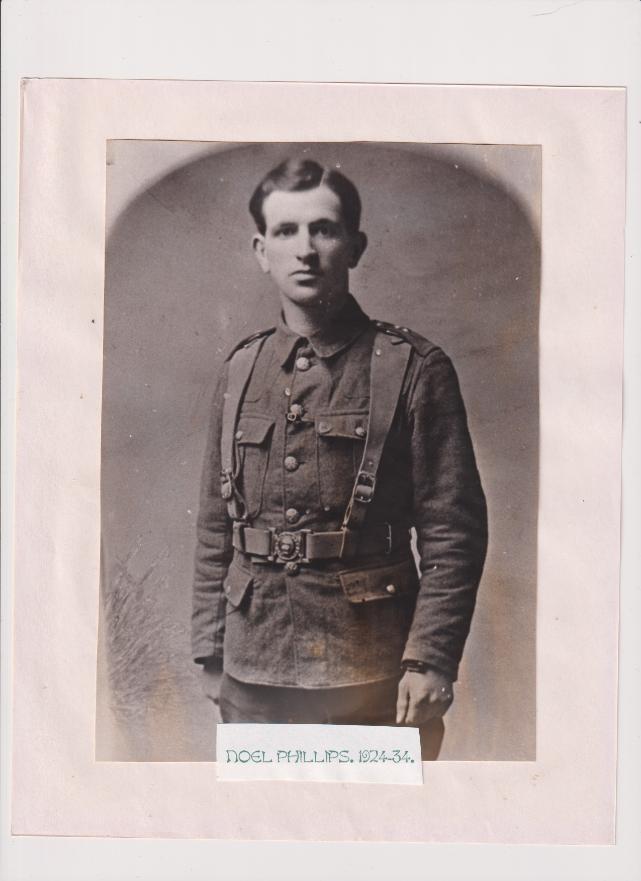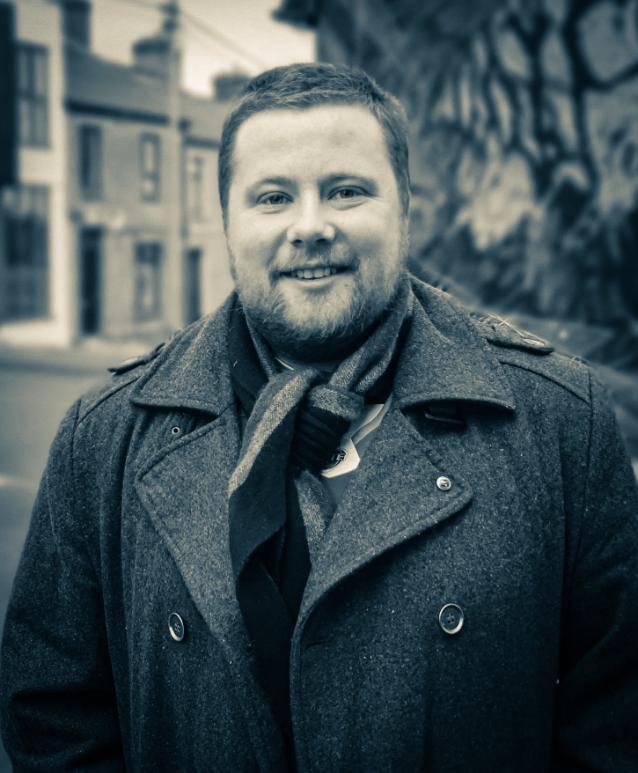Frank N. Phillips (1888-1944): First Elected Chairman of the Waterford City League
07/05/2025 - 10.32
Cian Manning
Francis Norbert Phillips was born on 1st June 1888 in Kinsale, Co. Cork. His father, Michael Aloysius, was a hotel owner based at Main Street in the West Cork village. A descendant of Frank Phillips has suggested that his father was Welsh, and that he once served as a Sergeant at Camden Fort in Cork. The 1901 census shows that young Francis moved from County Cork to live with his sister Geraldine and her husband Alfred Crane (a photographer) at 6 Catherine Street in Waterford. He lived there with his mother and sister, Edith. Frank was making waves in Waterford sporting circles by his early 20s. He was vice-captain of the Waterford Bicycle Club in 1910. The 1911 census shows that Phillips was a boarder with the Griffith family at 64 Poleberry, with his occupation recorded as ‘photographer.’
Francis followed in his father's footsteps with a career in the military, joining the Sportsmen's Battalion of the Royal Dublin Fusiliers, which was formed by the Irish Rugby Football Union. In autumn 1914, when the rugby season was stopped, the Irish Rugby Football Union Volunteer Corps was created. By September, it had 250 members.
The Corps was divided into two outfits: D Company of the 7th Battalion of the Royal Dublin Fusiliers and a group of older men who stayed in Dublin. Phillips served as a captain in D Company (known as ‘the Footballers’) with the British Army. He numbered the “Pals’ battalion” which was largely made up of the Dublin rugby fraternity, who would fight in the First World War. The 7th (Service Battalion) was formed at Naas in August 1914, as part of the First New Army. The first contingent of the Pals left the parade ground at Trinity College, Dublin, and made their way to Kingsbridge Station behind a Royal Irish Constabulary band before boarding the train for the Curragh. The D Company continued to train at Basingstoke, with the company departing for Gallipoli in the summer of 1915.
When they sailed to what is now the European part of Turkey, Gallipoli, the Italian form of the Greek ‘Kallípolis’ meaning ‘beautiful city,’ D Company numbered 239 men. The first week of August, they reached the peninsula, which faces south-west into the Aegean Sea, and joined the Allied campaign. Seven weeks later, as the company prepared to sail for Lemnos (now the 8th largest island of Greece) their number stood at 79 men. The battalion had participated in the Battle of Sari Bair and engaged in the capture of Chocolate Hill and Hill 60. On 16th August, the company attempted to dislodge a group of Turkish bombers with a bayonet charge in broad daylight at Kireçtepe losing three commanding officers and 54 men. The August Offensive at Sari Bair was the final attempt by the British Army to take control of the Gallipoli peninsula during the Great War. Those who are Gaelic Games history enthusiasts may recall that Hill 16 at Croke Park was previously known as Hill 60 until the 1930s to mark the bloody encounter between the 5th Battalion of the Connaught Rangers and the Turkish Army in August 1915.
Lieutenant-General Sir Bryan T. Mahon wrote of D Company that ‘it was unexcelled in the British Army for bravery, dash, discipline, and a sense of duty.’ Phillips suffered gunshot wounds on 7th August and dysentery during the campaign at Suvla Bay. Henry Hanna's work The Pals At Suvla Bay gives us some insight into the manoeuvre in which we believe he was injured when the Allied Forces tried to land ashore:
All through the landing of these battalions on “C” Beach on the morning of August 7 the Turkish guns alternated their fire on the beach and the lighters as they came in, usually four shells on the beach and then the next four on the lighters. One lot of the 7th Dublins, the first load, suffered most severely while in the lighters. Another lighter load, with another regiment on reaching the shore, was found to have had seventeen casualties, and the lighter itself presented the appearance of a shambles.
Such was Phillips renown in sporting circles, when news of his wounding reached Irish shores the Irish Independent (10th September 1915) carried his picture with the following lines:
PLAYED THE BIGGER GAME
Frank Phillips, well-known in Irish Rugby and Cycling circles, was wounded whilst serving with the Dublin Fusiliers’ Pals’ Brigade at the Dardanelles.
He re-joined his battalion at Salonika in October 1915. Phillips became a 2nd Lieutenant with the Old Toughs. Around May 1917, Phillips was called up to the 11th Battalion of the Dublin Fusiliers. He had previously applied for the job of “observer” in the Flying Corps. Subsequently, he was attached to the Royal Flying Corps and Royal Air Force, firstly as a 2nd Lieutenant (temporary) in March 1918. Frank was made Lieutenant on 1st April 1918, where he was deemed to have served with great distinction.
We learn from his records with the Air Force that he was based in Reading then Hythe, Kent before being assigned to No. 108 Squadron on 10th December 1917. The unit was only formed the previous month at the Lake Down Aerodrome near Stonehenge. They were equipped with Airco DH.9 bombers. Though, Phillips was only with the unit for less than three weeks when he was deployed to No. 102 Squadron, which moved to France and specialized in night-time attacks behind enemy lines targeting railway stations. Phillips was wounded in France on 26th May 1918. Phillips’ Medal Index Card shows that he was entitled to the Victory Medal and the British War Medal, which were awarded to those who served in the British Army during the First World War and overseas, such as in the Royal Flying Corps. As of the date of entry on Phillips’ Medal Card (dated 4th October 1922) he was yet to receive these honours for his service.

Frank N. Phillips. Source: Author's Collection
Phillips married Gertrude Mary Delaney from Enniscorthy, Co. Wexford, in 1918. After the end of the conflict in Europe, Phillips moved to Waterford and opened a photographic studio at 8 The Mall. Phillips was interested in various sports. He was a member of the Waterford Wheelers’ Cycling Club. Phillips played for the Waterford City Rugby Club until his late 30s, while his involvement with cricket in the later years was as an umpire. The Waterford Boat Club once had him as vice-captain, a long-time serving committee member, and later a coach for the club. All of these efforts were innately motivated by his love of sports, but also served as important networking opportunities for his profession as a photographer and promotion of his sports apparel and equipment store.
Phillips is a significant figure in soccer in the city, not only with the Waterford & District Junior League, but also later with being involved with Waterford Celtic AFC, which entered the Free State League in 1930. The same year, he was part of a committee that sought to raise funds for the improvement of St. John's Church by organising a tug-of-war, comic rugby match, and a boxing tournament. We could speculate that such efforts were inspired by his time in the British Armed Forces, as the activities promoted were popularly used by Anglican members to raise communal funds. In September 1930, Phillips numbered the group who established a new Waterford Athletic Club, the Waterford Athletic Association. He served on the sub-committee to organise its first tournament, which also included Peter O'Connor, Richard Hearne, and Chief. Supt. Leahy, who would serve as a contact with the Scottish entertainer George French. The athletic body decided to affiliate itself with the IABA.
Phillips is an important documenter of the early years of soccer in Waterford, taking photographs of teams. In addition to his photography studio on the Mall, Phillips also had a sports outfitters business. Frank’s wife Gertie was a tobacconist, who ran a confectionery and newsagents. They had six sons and a daughter together. Frank's sporting endeavours were not prevented by a large family, as Phillips was present at the formation of a new hockey league for men's and ladies' teams in Waterford and its surrounding areas at the end of 1934. A year later, he was noted as chairman of the Waterford Men’s Hockey Club.
When the Second World War started, he joined the A.R.P. and became the Area Warden for Waterford city. During the Spring of 1941, Phillips assisted the A.R.P. services, the Catholic Boy Scouts (led by Brother Bruno), the Baden-Powell Scouts, as well as members of the general public in assembling 25,000 respirators or gas masks over the course of 9 days and completed by early March. Sadly, Phillips did not live to see his adopted city after the Emergency. The Munster Express noted in his obituary that ‘there was scarcely a sporting organisation in the city of which he was not a member.’ His final weeks saw him critically ill at Maypark Nursing home. He died on 15th March 1944 aged 55 years. It appears that Phillips suffered from myocarditis, an inflammation of the heart muscle, which is rare, but often caused by an infection in the body, such as the common cold or influenza.
Phillips’ obituary in the Waterford Standard on Saturday 18th March 1944 noted:
When advice was needed it was a case of “ask Frank Phillips, he’ll tell you.” In his youth he was an all-round sportsman, and he never lost interest. Schools hockey in the South East owed him much, and he was a founder of the South Eastern Hockey League. He was in constant demand as an umpire for these games. He has been Chairman of the Waterford and District Table Tennis League since its inception.
Francis Norbert Phillips must be considered one of the most influential figures in the sporting life of Waterford city and county. He engaged in numerous sports as a player, coach and administrator. His photography of the early teams and players in the story of the Waterford & District Junior League are priceless. Even the military tradition of the Phillips family continued, with two sons following his path. His son was Colonel William Phillips, who was an Irish Army officer who was one of 350 United Nations-Iraq Military Observer Group who went to Iraq in August 1988. He joined as a cadet after leaving Waterpark College. The Phillips family deserve more recognition than they currently receive.
Biography
Cian Manning is an independent researcher based in Ireland’s oldest city, Waterford. He has previously authored Waterford City: a history (2019) and ‘I Love Me County’: Waterford Sporting Stories (2024) for The History Press. To mark the centenary of the Waterford & District Junior League, Cian wrote a history of the local soccer league, titled ‘Our League’: Waterford & District Junior League, A Centenary, in 2024. Additionally, he is a frequent contributor to Ireland’s Own, Munster Express and WLR FM. Cian can be contacted on e-mail at - camanning93@gmail.com



/prod01/wlvacuk/media/departments/digital-content-and-communications/submitted-news-images/Smelting-knife.png)
/prod01/wlvacuk/media/departments/digital-content-and-communications/images-2024/250630-SciFest-1-group-photo-resized-800x450.png)
/prod01/wlvacuk/media/departments/digital-content-and-communications/submitted-news-images/Way-youth-zone-August.JPG)
/prod01/wlvacuk/media/departments/digital-content-and-communications/images-2024/Arthi-Arunasalam-teaser.jpg)
/prod01/wlvacuk/media/departments/digital-content-and-communications/submitted-news-images/Muslim-woman-playing-football.jpg)
/prod01/wlvacuk/media/departments/digital-content-and-communications/submitted-news-images/Business-School-800x450.jpg)
/prod01/wlvacuk/media/departments/digital-content-and-communications/submitted-news-images/University-of-the-Year.jpg)